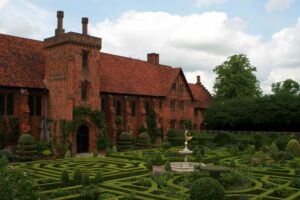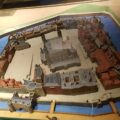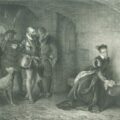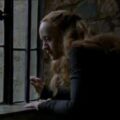
On this day in history, the 18th October 1555, Elizabeth finally received permission from her half-sister, Mary I, to leave court and travel to her own estate at Hatfield, rather than return to house arrest in Woodstock.
Elizabeth had been treated with suspicion by Mary and her council since Wyatt’s Revolt in early 1554. David Starkey says of the Revolt:-
“The rebellion of 1554 – known from the leader of its most important sector as Wyatt’s Revolt – brought Elizabeth to her nadir. It led to the most dangerous and difficult time of her life when she feared imminent execution or murder. She even expressed a preference as to how she should die: like her mother, by the sword, rather than by the axe.”1
Wyatt’s Revolt
The aim of the 1554 rebellion, or rather a series of uprisings co-ordinated by men such as Sir Thomas Wyatt (the Younger), the Duke of Suffolk (Lady Jane Grey’s father), Sir Peter Carew and Sir James Croft, was to block Mary’s marriage to Philip of Spain, dethrone Mary and replace her with Elizabeth, who would marry Edward Courtenay. Unfortunately the rebels were unsuccessful because Mary was tipped off. The uprisings in the Welsh Marches, Midlands and South-West came to nothing and in London Wyatt was forced to surrender. This challenge to Mary and her government led to the executions of Guildford Dudley, Lady Jane Grey and the Duke of Suffolk in February 1554, and Elizabeth being formally charged of involvement in the rebellion. In his trial on the 15th March 1554, Wyatt had mentioned that he had sent Elizabeth a letter and that she had replied, “but not in writing”2, and this was enough for Queen and Council to move against Elizabeth. p140
To the Tower
On the 16th March 1554 Elizabeth was formally charged with involvement in the conspiracies of Carew and Wyatt and was informed that she was going to be taken to the Tower of London. When the Marquess of Winchester and Earl of Sussex arrived on the 17th to escort her to the Tower, Elizabeth wrote her famous Tide Letter, “the letter of her life”3, in which she reminded her half-sister of her promise not to condemn her without proof and without talking to her, and denied the charges laid against her. As Elizabeth wrote this letter, the tide of the Thames turned and it was impossible to take her to the Tower. Winchester and Suffolk were forced to return the next morning, Palm Sunday, and escort her along the Thames to the Tower, the place where her mother, Anne Boleyn, had been held and executed.
David Starkey describes how Elizabeth was taken from the landing place at Tower Wharf, across the drawbridge, past the Tower menagerie, under the Bloody Tower, past Lady Jane Grey’s scaffold, through Coldharbour Gate and into the royal palace, the apartments refurbished for her mother’s coronation and the exact same place that her mother spent her last days in May 1536. We can only imagine the fear that Elizabeth felt – was she too going to be executed as a traitor?
Over Easter 1554, Elizabeth was interrogated by members of Mary’s Council about her contact with the rebels regarding her removal from Ashridge to Donnington Castle (Sir James Croft, one of the rebels, had actually called in at Ashridge to advise Elizabeth to move to Donnington and Wyatt had also written to her about this). Elizabeth replied that she did remember a conversation between her officers and Croft over her going to Donnington, “but what is that to the purpose, my lords but that I may go to mine houses at all times.”4 Elizabeth kept her nerve and her head, even when Wyatt went to the block on the 11th April. Fortunately for Elizabeth, Wyatt did not implicate her any further and, instead, exonerated her in his execution speech:-
“And whereas it is said and whistled abroad that I should accuse my lady Elizabeth’s grace and my lord Courtenay; it is not so, good people. For I assure you neither they nor any other now in yonder hold or durance was privy of my rising or commotion before I began. As I have declared no less to the queen’s council. And this is most true.”5
Elizabeth was not put on trial and, instead, was released on the 19th May, the anniversary of her mother’s execution.
House Arrest
Although Elizabeth was released from the Tower, she was not a free woman. Her barge took her from the Tower to Richmond, escorted by Sir Henry Bedingfield, Constable of the Tower, and a troop of men. After a night at Richmond, Elizabeth and her guards travelled to Woodstock, stopping at Windsor, West Wycombe and Rycote on the way. On the journey, Elizabeth was overwhelmed by the show of support from the people – she was given gifts of cakes and wafers at High Wycombe, men rang the church bells in Aston Rowant and the people of Wheatley, Stanton St John and Islip all turned out to greet her and show their support.
At Woodstock, Bedingfield was to keep Elizabeth securely under house arrest. She was to be treated well but was not to converse with any suspicious person or be allowed to send or receive any “message, letter or token”6. As Starkey points out, Bedingfield’s task was a tricky one, seeing as the palace was huge and there were “three doors only that were able to be locked and barred”7 , plus the prisoner was waited on by her own devoted servants, who could send and receive messages for her. What I find bizarre about the situation at Woodstock was that Elizabeth, the prisoner, had to pay for the food and drink for not only her servants but for Bedingfield and his men – strange, but true. This caused a headache for Bedingfield because one of Elizabeth’s most trusted and loyal servants, Thomas Parry, was in charge of the household accounts, a man that Bedingfield was meant to removed. Removing Parry would have meant Bedingfield doing Parry’s job, i.e. taking financial responsibility for the household, so Parry was removed from the palace but only so far as the town, the Bull Inn, allowing him to continue with his job. The result of this move, as David Starkey points out, was that Elizabeth and Parry “ran rings round him and often barely bothered to disguise the fact.”8 Elizabeth’s servants often visited Parry at the inn, on the pretext of discussing household business with him, but these visits allowed Parry to keep Elizabeth up to date on what was going on outside of Woodstock and to keep her connected with the outside world.
To Court
On the 17th April 1555, after nearly a year at Woodstock, Elizabeth was summoned to court to attend her pregnant half-sister. Elizabeth arrived at Hampton Court around a week later and was given secure accommodation in the Prince of Wales’s Lodging. A few days after her arrival, bells were rung announcing the safe arrival of a prince, but it was a false alarm. In May 1555, Elizabeth asked to see the council and was visited by Gardiner and a few councillors, in whose presence she refused to submit or acknowledge her guilt. About a week later she was taken to Mary’s bedchamber where she was chided for her refusal to submit to her sister and Queen. The sisters were able to reconcile and Elizabeth was at Mary’s side as she tried to keep up the pretence of her pregnancy and was then deserted by her husband in August 1555 as he travelled to the continent to take up the reigns on the abdication of his father, Charles V. It was a hard time for Mary and Elizabeth couldn’t help but pity her older half-sister.
To Hatfield
Finally, after over 18 months of watched and held securely, Elizabeth was granted permission to leave court and to go to Hatfield, where she could get on with her life. There she could be her own woman and surround herself with people she loved and trusted. Thomas Parry joined her, as did Kat Ashley as soon as she was released from house arrest. We can only imagine Elizabeth’s relief and happiness. Since March 1554 she had lived under the shadow of the axe, fearing that she would be executed as a traitor or assassinated, it had been a stressful and frightening time, but now she was free. How true the words Elizabeth was said to have etched on the window at Woodstock:-
“Much suspected by me,
Nothing proved can be.
Quod Elizabeth the Prisoner”
Notes and Sources
- Elizabeth, David Starkey, p131
- Ibid., p140
- Ibid., p141
- Ibid., p145
- Ibid., p147
- Ibid., p154
- Ibid.
- Ibid., p157









No wonder Elizabeth was such a nervous nellie! Her early life would be enough to crush all but the most invincible spirits. I think she and her mother were both ‘high strung’ which made them difficult to live with on occasion. It may be this that led to Anne’s downfall–Henry found her too hard to deal with. WEll, no wonder. How scary to have been a woman at that time! THanks Claire–another great job!
I think historian Mary M. Luke wrote that by the time of Elizabeth’s arrival at Woodstock, it was in pretty poor shape, this being the Woodstock of “fair Rosamunde” fame. I always wondered about Thomas Parry. I’ve heard the man couldn’t keep any sums straight and that Elizabeth ended up donig her own accounts in the end anyway.
Anyway Claire, another bang-up job. I was struck by the ironies in all of this: Elizabeth being released on the date of Anne’s execution. Elizabeth being held in the same apartments where her mother had one of her greatest moments and then spent her last days. (And THANK YOU for the clarification on where Elizabeth stayed during her time in the Tower. When I visited them in 2000, the guide told us that she and Anne resided in one of the Tower cells. Even in Elizabeth R, the Princess is placed in a common cell). I didn’t realize the royal prisoner was forced to pay for her those imprisoning her; I guess it’s a good thing Mary didn’t demand some sort of payment for “the Crown’s pain and suffering”
A final comment — I was thrilled to see the Tide Letter in 2000 when it was on display at Hatfield House. To study that handwriting, to read the actual words in HER hand, to see those long strike marks to fill the empty spaces…the guide could see how choked up I was when I told her that she had NO idea what that meant to me!
How relieved and happy Elizabeth must have been when Hatfield came into view! It must have seemed like the end of (or a respite from) an 18 month-long nightmare. And she was never entirely the same person afterward, as many people who have suffered such a trauma will tell you. To the end of her life, she was still composing prayers of thanks to God for her deliverance “from the prison to the palace.” She knew what a near thing it had been, and I can’t imagine the anguish of feeling the need to ask for her ‘choice’ of the method of her execution.
She was suffering the same emotions that her mother had felt, in the same room where her mother had felt them. She must have felt very close to her mother at this time, and was determined to meet her death with the same courage her mother had. What extraordinary women! I so wish Anne’s story could have been different, with her living to see Elizabeth as queen, although I shudder to think of Mary as queen with Anne still alive to wreak her ‘vengeance’ on. Had Henry not beheaded Anne, Mary might have decided to make Anne’s ‘prophecy’ of an English queen being burned come true! And we’d still be remembering the tragedy of Anne Boleyn, but for a different reason.
I am always amazed by Elizabeth’s ability to deal with so much pressure at such a young age. Today we know about post-traumatic stress and can get help but Elizabeth managed to cope with her experiences and to learn from them.
Hi
Im interested in visiting Hatfield House after the tour next year. I have limited time though. Do you think its worth a visit ?
Thank you
Kate, you will not be able to see the old palace sadly.It’s closed to visitors or was when I went a few years ago. The New House is built to the honour and glory of the Cecils. It does have a good copy of the rainbow portrait in the Great Hall though!
Thanks for the info Fiz, much appreciated 🙂
lively, wonderful to read…
I am now searching for information about Elizabeth’s temper, nervous responses e.g. to loud noises, and her ability to be ‘ill’ when it suited her – can anyone point me in the right direction, please?
I too am impressed by her ability to hold her own under such dreadful and long lasting stresses and strains… it is strange to me that this ghastly age should produce such sublime works of art, literature, and music…
Hi,
Mary must have had some affection for Elizabeth because I beleive Elizabeth could have very easily been executed if there wasn’t some feelings there.
Mary and Elizabeth both had pretty hard childhoods, you would think that being born into royalty would be a fine lifestyle, but I see this is not true at all!
Julie B –
I believe Mary had great affection for Elizabeth, although her position as Queen caused her much conflict with her half-sister – as, in the future, Elizabeth I had much conflict with her cousins who were likewise in a position to knock her off the throne.
Mary was part of Elizabeth’s life when she was a toddler, and to all accounts, Elizabeth was an engaging, lively, bright little girl. It would be very difficult to put aside those memories and to believe that toddler was capable of plotting behind one’ back. I think Anne Boleyn’s plan to humiliate Mary by making her Elizabeth’s ‘servant’ during Elizabeth’s babyhood actually saved Elizabeth from the sword as a young woman.
I have four sisters, and while I’ve wanted to do them bodily harm during my own childhood (over issues like taking the last pair of decent knee-socks from my cupboard on a school morning) it would never come to pass because of the bonds of sisterhood – something that I think Mary I would perhaps not like to agree with, but would nevertheless due to the truth of it.